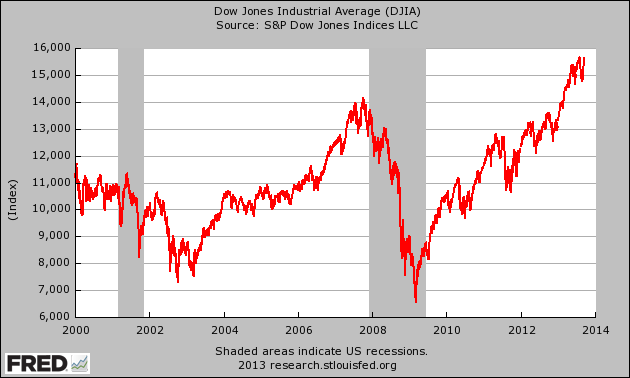DOW JONES INDUSTRIAL AVERAGE MILESTONES DJIA from 1896 Record High Greatest Gains Losses
Post on: 8 Май, 2015 No Comment

DOW JONES INDUSTRIAL AVERAGE MILESTONES
Dow Jones & Company, which is now a unit of Rupert Murdoch’s News International, was founded in New York City in 1882 by Edward Davis Jones. Charles Henry Dow and Charles Milford Bergstresser.
The cornerstone of Dow Jones is its flagship publication, The Wall Street Journal, which also happens to be one the world’s leading English language business publications — — the strident opinion section may not be one’s cup of tea.
CME Group acquired 90% of the Dow Jones’ namesake indexes business in 2010. A year later, McGraw-Hill, owner of Standard & Poor�s, agreed a deal providing for 73% of a new joint venture, while CME, the US�s biggest futures exchange operator by revenues, would own 24.4% and Dow Jones the remaining 2.6%.
The Dow Jones Industrial Average is an index of 30 blue-chip US stocks.
At 117 years, it is the oldest continuing US market index. It is called an average because it originally was computed by adding up stock prices and dividing by the number of stocks. (The very first average price of industrial stocks, on May 26, 1896, was 40.94.) The methodology remains the same today, but the divisor has been changed to preserve historical continuity. The DJIA is the best-known market indicator in the world, partly because it is old enough that many generations of investors have become accustomed to quoting it, and partly because the U.S. stock market is the globe’s biggest.
The industrial average started out with 12 components in 1896, rising to 20 in 1916. The 30-stock average made its debut in 1928, and the number has remained constant ever since.
The Dow peaked at 381.17 on Sept 3, 1929. It crashed on October 28 and 29, 1929, falling from 301 to 230 or 23.6%
One year after the peak, the Dow closed at 237.54, down 37.3% from its peak. It continued to slide until July 8, 1932 where it bottomed at 41.22, down 89.2% of its value over 2.5 years
The Dow did not cross above 381 again until Nov 23, 1954, over 25 years after its 1929 peak.
John Authers of the Financial Times wrote in May 2013 that the Dow should be consigned to history: Crucially, the Dow�s illogically chosen members are weighted by their share price, rather than their market valuation. This means companies that happen to have a high share price can outweigh larger companies with a smaller price per share.
This is ludicrous. For example. IBM now accounts for 11.1% of the Dow and has a market value of $228.7bn. ExxonMobil, back as the world�s largest company following the decline of Apple (never a Dow member). has a market cap of $398.5bn, but a Dow weighting of only 4.8%.
On Nov 21, 2013, Nike, a Dow component, had a market cap of $69.8bn and Google, which owns Motorola Mobility, an industrial company and is not a Dow member, had a valuation of $345.5bn.
How are stocks picked for the DJIA?
The editors of The Wall Street Journal select the components of the industrial average. They take a broad view of what industrial means, too; in essence, it is almost any company that isn’t in the transportation business or isn’t a utility (because there also are Dow Jones Averages for those kinds of stocks). In choosing a new company for the DJIA, they look among substantial industrial companies with a history of successful growth and wide interest among investors. The components of the DJIA are not changed often. It isn’t a hot stock index, after all, and the Journal editors believe that stability of composition enhances the trust that many people have in the averages. The most frequent reason for changing a stock is that something is happening to one of the components, such as being acquired. Whenever one stock is changed, the rest are reviewed.
In September 2008, the partial-nationalisation of the insurance giant AIG, prompted its ejection from the index and a replacement by Kraft Foods. in June 2009, General Motors and Citigroup were also dropped.














